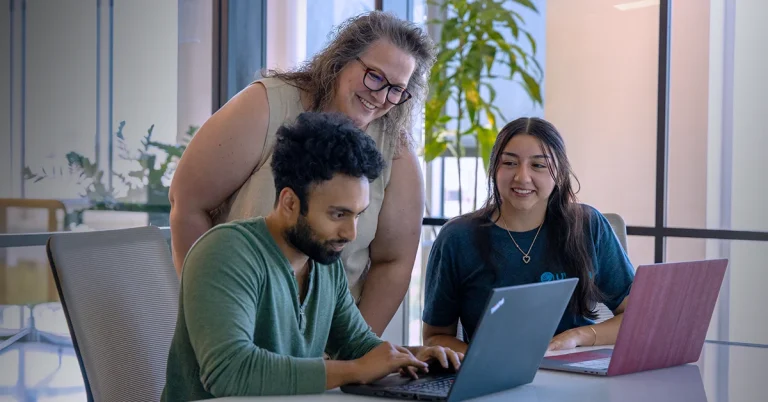Maria Grandinetti, Ph.D., RN, BSBA, CNE
Wilkes University
The nationwide outbreak of COVID-19 brought with it a wave of uncertainty and many questions in higher education. With each day’s new concerns and challenges, nurse educators realized that things wouldn’t be going as they’d initially planned. I’m sure you can relate. We quickly transitioned the traditional face-to-face classroom and clinical courses to online, hybrid, and asynchronous formats as a necessity.
As you can remember, the originally planned classroom and clinical experiences, where students would have opportunities to care for patients, practice clinical skills, and gain knowledge of nursing from their professors, were replaced with online educational resources. Interactive assignments included virtual simulated nurse-patient experiences and telehealth visits, giving students an insight into an effective healthcare delivery alternative during a pandemic. Relevant textbook resources were utilized, guest speakers were invited to connect with students remotely, and virtual activities became vital to delivering the curriculum. Lectures and discussions were either live-streamed or recorded.
Even before the troubles of the pandemic, some weighty statistics reside in the backdrop for the nursing profession. The U.S. Bureau of Labor Statistics (2020) projected that 175,900 new registered nurses will be needed each year through 2029. These are estimated to be necessary to fill newly created positions as well as to replace retiring nurses. This forecast of the growing need for new nurses is top-of-mind for nurse educators who felt a sense of responsibility, and urgency, to educate and graduate students, to fill this “gap.”
Students faced unique challenges after leaving campus. Nurse educators anticipated this and communicated their compassion and willingness to help. Decisions were highly focused on students’ needs, with the intent of providing them the best opportunity to succeed in their remote studies. For example, some students did not own a laptop computer; accordingly, arrangements were made for borrowing them. Additionally, internet “hotspots” were created in designated parking lots on campus for students with poor or no internet service at home.
Campus academic support services were also available for students, via remote access. Students continued to be able to work with peer tutors, obtain support from test-taking and learning personnel, speak with experts in the technology office, and gain the assistance of a research librarian. All efforts were made for the transitions to be as seamless and non-disruptive as possible considering the environment.
We learned that students felt both physically and emotionally disconnected from their connective support network of friends, fellow nursing students, and instructors. Students nearing the end of their nursing program occasionally felt unsettled, worrying about their ability to meet program requirements and to graduate on time. But educators and students persevered, as new ways to continue lessons and assess learning were implemented, and those who were expected to graduate did.
It’s no surprise that early on, we had feelings of uncertainty on many levels. Many questioned if teaching students remotely would be on par, and as effective as traditional classroom teaching and learning. Our goals remained the same as those pre-pandemic — to prepare their students to be safe, skilled nurses who were intended on passing the NCLEX-RN on their first attempt. Over time, the trepidation lessened. Our confidence increased as the curriculum was delivered, and students learned. Feedback received from students revealed that their online learning experience was greatly enhanced when they felt a sense of community online. This was not accidental. We worked hard to create a supportive online environment, acting as coaches and mentors. Along with the support of the faculty and their community of peers, students were well aware that they were not alone.
Here are five lessons learned by nurse educators while teaching in a pandemic, and some insights to help plan future semesters if the pandemic continues or when faced with similar periods of widespread disruption.
#1 – Embrace the New
On a positive note, the circumstances of the pandemic accelerated the realization that many nurse educators’ teaching methods were outdated and in need of refreshment. The upheaval brought the necessity of change, and there was no other choice than to welcome and embrace it. There was simply no time to adapt comfortably. This required educators to drive these changes nimbly, with flexibility and patience in the overall process. The respectful collaboration among educators was essential, and collective “buy in” was critical once plans were set. Resistance and dissension would be further damaging. Developing new and/or modified ways to deliver curriculum was time-consuming and frustrating, but overall, the outcomes were reached.
#2 Communication Is Key
The pandemic led to a loss of sense of control over simple and routine things. Steering through the disruption was improved by timely, concise, and professional communication between nurse educators. Virtual meetings, phone calls, and email messages wholly replaced the ability to stop by another person’s office to talk. Productive and collaborative discussions took place, resolving problems with common goals in mind. Nurse educators supported each other and bonded as they worked together.
#3 – Careful Selection of Learning Resources
Make efforts to ensure all assigned work is for targeted learning outcomes, and not merely “busy work” for students to complete. Look to integrate additional or alternative learning resources promptly to better prepare expected nurse graduates. Knowing that real-life clinical experiences were not possible in the semester, there was a need to early identify readiness to graduate and NCLEX® testing predictor for success. Integrating the UWorld QBank was a powerful tool, providing students with thousands of practice questions to prepare for the NCLEX. The two self-assessments revealed information related to content warranting further review and practice. Its use and intended forward trajectory for NCLEX success can be easily tracked by students and nurse educators. Through the knowledge that the exam schedule would be delayed nationwide, extending the use of this and other preparatory programs would serve as a benefit for students. In turn, schools of nursing also benefit from a greater chance for students’ passing rates and increased board scores. These advantages will trickle down to the healthcare agencies as incoming newly hired nurses will be prepared for clinical practice.
#4 – Remember Students’ Technology Needs
The traditional ages of undergraduate nursing students are between 18–24 years. Many of these young adults effortlessly use smartphones to traverse the Internet and engage on social media sites. For some, however, the ability to access the internet and work with computer programs is challenging. Navigating online learning platforms, obtaining literature from an online library site, scanning a document or file, and presenting online are examples of tasks that they will likely need assistance with initially. With knowledge of this in advance, nurse educators can intercede to bridge the gap between personal and educational/professional use of technology. The office of technology on campus can also be a tremendous resource for educators and students.
#5 – Continue to Be Caring, but From a Distance
Nurse educators are no different from nurses who provide care to patients in acute and chronic care settings. A nurse educator-nursing student relationship is similar to that of a clinical bedside nurse-patient relationship. Trust and respect develop between the two over time and recurrent encounters. Nurse educators did a great job of this during a pandemic. A smile during a Zoom session, being available to students, and instilling the confidence in their students that they support their success in nursing education truly made a difference.





